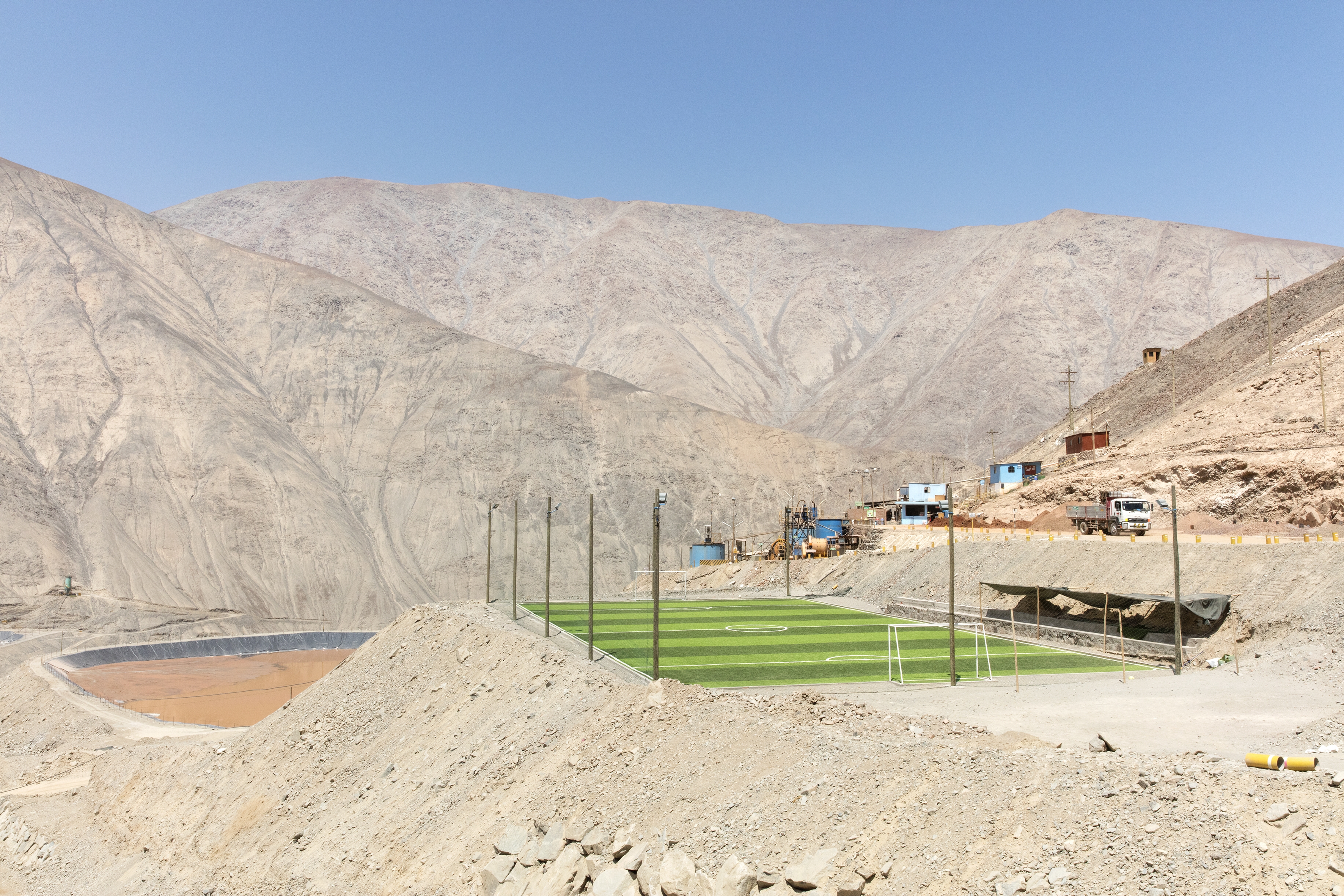The Canary and the Hammer
Artist Lisa Barnard unveils the shimmering paradox of gold, an enduring symbol of beauty and power. Through her lens, hidden voices emerge and unseen truths surface, weaving a visual tale of gold’s role in human history and the global economy.
Gold has fascinated humanity for millennia. It symbolises wealth, power and beauty, and remains a safe haven for investors and governments. Beyond finance, it has also proved to be a crucial component in medical and space science.
During her four-year endeavour across four continents to uncover the complex story of gold, Lisa Barnard encountered stories that illuminate gold’s dark side. Gold mining is one of the most destructive industries in the world. On top of its high emissions intensity, it drives deforestation, contaminates water, and endangers entire ecosystems. Workers are often exploited and exposed to health hazards, and communities displaced.
But Barnard also found initiatives which try to improve the industry. Like fairtrade and fair mining cooperatives where small-scale miners are equal shareholders, receive fair wages and have access to medical and retirement support.
Her investigation raises many questions. Can gold mining ever be sustainable? Does the global economy really require gold as a financial safeguard of last resort? Do we already have all the gold we need for its medical and scientific benefits, and can recycling replace extraction?
Currently nearly half of all extracted gold is used for jewellery. Could gold, like ivory and fur, lose its shine as its social and environmental costs become clearer? We wonder; would you still wear it if you knew the true costs?
Let’s dream together of a circular and ethical gold economy!
ING Art Collection broadens awareness of what is happening in society.
ING’s sustainability approach spans climate, nature and social agendas, recognising their interdependencies and how they affect each other, both positively and negatively. We support our customers to drive down their emissions, and finance the solutions needed for the low-carbon economy of the future, while striving to empower people to play a part.
''Gold is the sweat of the sun, silver is the tears of the moon.” - Incan Proverb

Lisa Barnard, SOTRAMI processing plant with synthetic football field, Santa Filomena, Peru, 2016
Sweat of the Sun
To the Inca civilization, gold was the “Sweat of the sun”. The sacred substance linked to the sun god Inti played a central role in religious ceremonies and artwork. In the 16th century Europeans looted vast amounts of Inca gold. Their greed finally led to the destruction of the Inca Empire.
Gold mining is one of the most destructive industries in the world. It often displaces communities, exploits workers, and destroys pristine environments. It pollutes water and land with mercury and cyanide, endangering the health of people and ecosystems.
Luckily there are initiatives which try to improve the industry. Fairtrade and fair mining initiative Sotrami in Peru is one of them. It is a model for more ethical and socially responsible artisanal gold mining. The 166 small-scale miners are equal shareholders. Workers receive fair wages and have access to medical and retirement support, as well as education for their children.

Lisa Barnard, Old Building used by gold miners, Coulterville, California, USA, 2017
All that Glisters
The discovery of gold in the United States ignited waves of migration, speculation and transformation. Billions in gold fuelled infrastructure, agriculture and global trade. The legacy of gold - risk, desire and illusion - echoes in places like Las Vegas. The dream of sudden wealth persists, shaped by the same forces that once drove miners west.
The California Gold Rush (1848–1855) drew over 300,000 fortune seekers to the West Coast. Settlers would freely claim ownership of land and consequently decimated the population of Native Americans.
Tens of thousands of Chinese migrants travelled to California to work in the mining industry. They fled from famine, war and rebellion. But in America they faced racism and exclusion. The Chinese Exclusion Act of 1882 was the first major federal law in the United States to restrict immigration based on race and nationality. It banned labourers for 10 years and made it difficult for Chinese residents to become citizens or re-enter the country.
The policy of anti-immigration and exclusionary tactics remains today, as the US seeks to further isolate itself from foreign influence.
“I and my companions suffer from a disease of the heart that can be cured only with gold.”
Conquistador Hernándo Cortés to Inca leader Moctezuma II, 1519

Lisa Barnard, Asteroids discovered and observed by NASA, 2017
Disease of the Heart
Gold has an enduring grip on the world: from imperial desire to cosmic reach. It has long fuelled ambition and conquest.
The search for and control of gold deposits was a major motivator for imperial expansion. Gold was crucial for international trade and monetary stability. Particularly for the gold standard, which underwrote the later industrialisation and economic growth in western imperial centres.
Systematic European colonisation began after Columbus’ ‘discovery’ of the Americas in 1492. The Spanish expeditions were, amongst others, followed by Portugal, Great Britain and the Netherlands.
King James I of Great Britain played a critical role in North American colonisation. An economic crisis prompted him to pursue resources elsewhere. The king signed a charter giving the Virginia Company of London exclusive rights to American territory. This was the directive to start mining for gold and silver.
The first 144 Englishmen to travel to North America were shareholders and investors. With the founding of Jamestown in 1607, the first permanent English settlement became fact.
The men endured famine, swamps, and conflict with the Powhatan tribe – which Matoaka, or as we know her, Pocahontas, belonged to.
“In 2021, one ton of e-waste was making 24 kilograms of gold. The gold extracted from e-waste makes its way back into the Hong Kong jewellery business.” - Lisa Barnard

Lisa Barnard, Reed Flute Cave, Guilin, China, China, 2016
The Fox and the Rooster
In the famous folktale, a clever rooster outwits a fox with foresight and cunning. The story’s moral is that cleverness and a firm grip on reality can defeat deceit and flattery, and that even cunning tricksters can be tricked themselves.
A similar thing happened in 1940. A chemist dissolved Nobel prize medals in a potent acid called aqua regia to shield them from the Nazis. He recovered the gold after the war. This acid is still used today, often illegally, to extract gold from e-waste. The method is considered thirteen times less expensive than the removal of gold from the ground.
Aqua regia is a combination of nitric and hydrochloric acid. The Latin title literally means ‘royal water’. It is so named for its ability to dissolve the noble metals – gold and platinum. The process of extracting gold using royal water is highly volatile and dangerous. It can lead to incidents relating to explosions, spills and, ultimately, physical harm. Despite this, aqua regia is particularly prevalent in the illegal extraction of gold from e-waste.
E-waste consists of discarded electronic appliances such as phones, computers, and televisions. It is one of the fastest-growing sources of rubbish in the world. These discarded devices can be highly toxic, containing lead and mercury, fatal to human health and the environment. But something else is embedded in their circuitry that makes them worth-while: gold.
From 1300 B.C., plants were used as guides in the ancient mining practice of China:
‘If in the mountain grow spring shallots, there will be silver under the ground; if leek in the mountain, gold.’
‘If in the mountain grow spring shallots, there will be silver under the ground; if leek in the mountain, gold.’

Lisa Barnard, Representation of a plant with light emitting leaves, 2018
Lycurgus and Ambrosia
Gold nanoparticles have been utilised in sculptures, tableware and other works of art for centuries due to the vibrant colours producedby their interaction with light. The mostfamous example is the Lycurgus Cup from the 4th century. It depicts Ambrosia destroying Lycurgus, a scene from ancient Greek literature. The glass in the cup changes colour fromred to green depending on the direction of the light.
These unique optoelectronic properties are now utilized in high-tech electronics, medicine and diagnostics. Gold nanoparticles are for instance used to help diagnose heart disease and are used as a conductor in printable inks. Gold is now advancing technology in such a way that it could end up helping and supporting the planet.
An international team of scientists suppor-ted by the G8 is cooperating in the Phytocat project. The research conducted by them is aimed at discovering plants with the ability to extract gold from soil, offering sustainable mining alternatives.